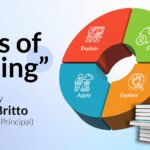In simple terms, a portfolio is a collection of the student’s work over a period that may lend itself to a certain form of assessment.
- A student portfolio ensures quality learning and monitors learning outcomes. A portfolio unlike a single attempt pen and paper test gives a qualitative understanding of the child’s learning journey. It provides substantial data to Compare and contrast students’ progress from the beginning of the academic session to the end of an academic session. A student’s portfolio is not only a diagnostic tool but helps in the prognosis of any future faulty understanding.
- A portfolio reveals an entire learning process as it can be handed over from one class to another and if accompanied by a synopsis the next teacher in charge gets a mine of information about how to handle the learner and plan meaningful lessons.
- Maintaining a student’s portfolio ensures education for sustainable learning. Unlike conventional exams, there is no stress on the learner. The learner has to only maintain a meticulous compilation of his entire work.
- The portfolio becomes an effective tool for education measurement if the teacher has planned the objectives and activities to match the objectives. It works best in achieving long-term academic goals.
- Portfolios can help teachers monitor and evaluate learning progress over time. Tests and quizzes give teachers information about what students know at a particular point in time, but portfolios can document how students have grown, matured, and improved as learners over a project, school year, or multiple years. For this reason, some educators argue that portfolios should not just be compilations of a student’s best work, but rather they should include evidence and work products that demonstrate how students improved over time.
- Portfolios are getting popular among learners too as they get to decide what they can place in their portfolio and thus accept responsibility for their understanding.
- The portfolio is not the easiest type of assessment to implement, but it can be a very effective tool. Portfolios show the cumulative efforts and learning of a particular student over time. They offer valuable data about student improvement and skill mastery. Along with student reflection, that data provides valuable information about how each student learns and what is important to him or her in the learning process.
- Today portfolios are not just restricted to hard copies. Online portfolios- digital portfolios/ e-portfolios are becoming a common feature in our classrooms.
- Portfolios can improve communication between teachers and parents. Portfolios can also help parents become more informed about the education and learning progress of their children, what is being taught in a particular course, and what students are doing and learning in the classroom.
- Portfolios are here to stay. They will always be an integral part of classroom assessment strategies that provide a mine of information to the teachers, the parents and the learners who are active participants in the teaching-learning process.
- Portfolios Enables faculty to assess a set of complex tasks, including interdisciplinary learning and capabilities, with examples of different types of student work.
- Helps faculty identify curriculum gaps, a lack of alignment with outcomes.
- Promotes faculty discussions on student learning, curriculum, pedagogy, and student support services.
- Encourages student reflection on their learning. Students may come to understand what they have and have not learned.
- The process of portfolio creation is a thought provoking activity it has specifically designed steps . The following points have to be kept in mind before adopting a portfolio approach:
What is the purpose of the portfolio requirement? To document student learning? Demonstrate student development? Learn about students’ reflections on their learning? Create a document useful to students? Help students grow through personal reflection on their personal goals?
Will portfolios be showcase or developmental?
When and how will students be told about the requirement, including what materials they need to collect or to produce for it?
What are the minimum and maximum lengths or sizes for portfolios?
Who will decide which materials will be included in portfolios- -faculty or students?
What elements will be required in the portfolio- -evidence only from courses in the discipline, other types of evidence, evidence directly tied to learning outcomes, previously graded products or clean copies?
Will students be graded on the portfolios? If so, how and by whom?
How will there portfolios be assessed to evaluate and improve the program?
What can be done for students who have inadequate evidence through no fault of their own? (E.g., transfer students)
What will motivate students to take the portfolio requirement seriously?
Having understood these requirements the portfolio will become a strong ally for the teacher and make the classroom record keeping more meaningful.










